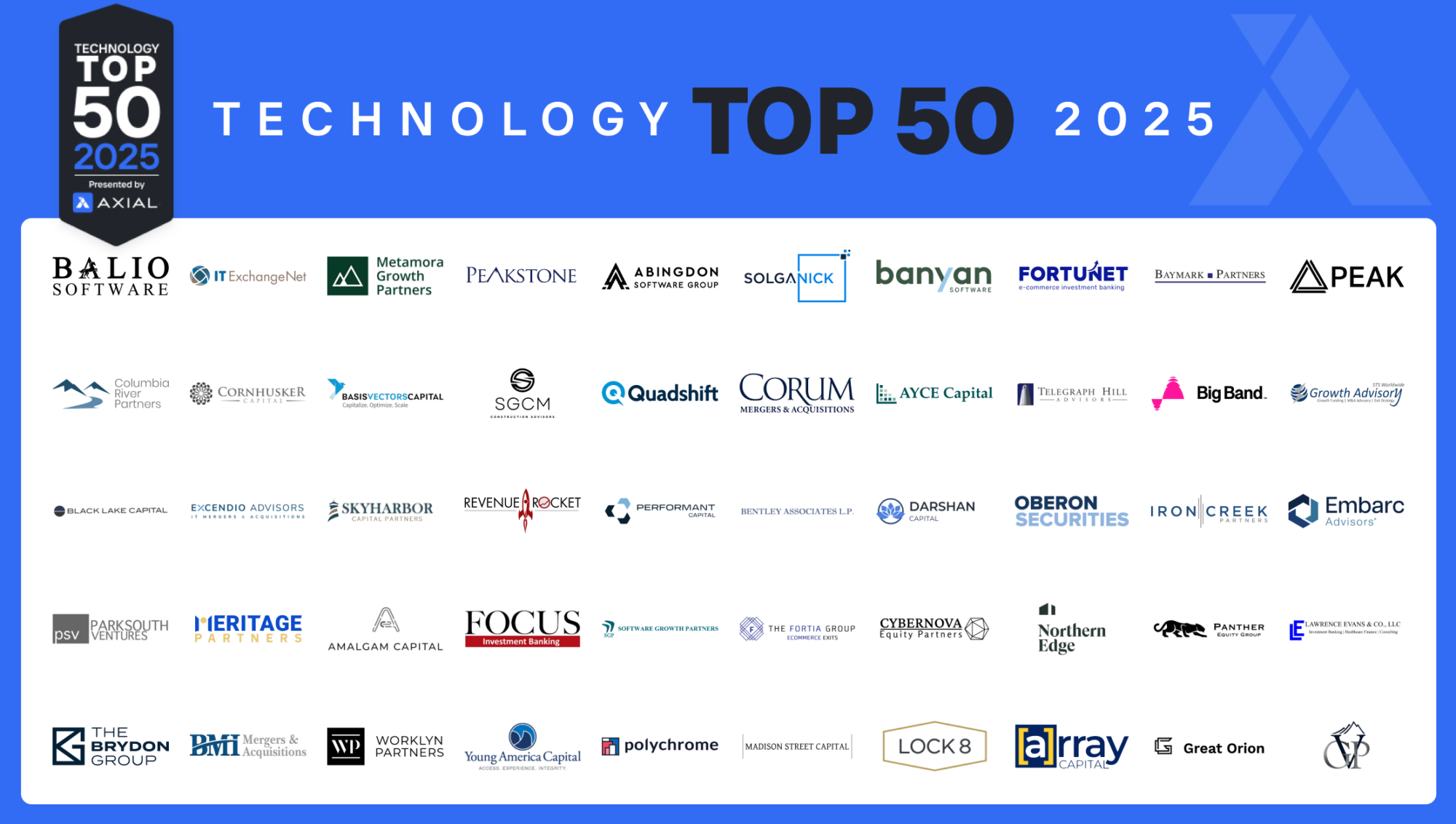
The Top 50 Lower Middle Market Technology Investors & M&A Advisors [2025]
Technology remains a steady presence in the lower middle market, representing ~13% of deals brought to market via Axial over…
Every salesperson is familiar with the concept of the “funnel” — the start to finish process of completing a sale from initial contact to signed contract. The concept is applicable across any industry where a transaction occurs between two parties, and M&A is no exception.
The Science of Deal Sourcing
As we watch deals on our network go from initiation to closing, we collect insights and data around the way they progress. The art of sourcing a deal comes to look a bit more like science when you consider the numbers.
It starts with some simple (but highly individualized) math. What is the amount of capital that a firm needs to deploy by year end? Based on the firm’s resources, personnel, and history, how many deals can you expect to get done this year? In order to deploy capital in a fund, business development professionals are charged with sourcing deals that not only fit their desired purchase price but also their holding period, desired return margins, and more. Every piece of the transaction must fit into a carefully orchestrated and often hard to predict system. Inevitably, the number of deals in the funnel decreases markedly from stage to stage.
What does it take to get a deal through to close? We’ll walk through the various stages of the M&A deal funnel and detail who should be involved in each phase.
Deals Seen
The funnel starts with every deal a firm becomes aware of, whether through inbound channels (brokers, bankers, or companies themselves coming to you) or outbound channels (tracking the industry, pursuing relationships, calling up CEOs, etc.) These are the deals worthy of announcing in a Monday morning investment team meeting. The firm has some vague understanding of the company’s financials, or some other metric that can be further researched and analyzed.
The number of deals a given firm sees varies widely depending on a number of factors, including team structure, bandwidth for sourcing as opposed to operating/managing, and how specialized the firm is.
Who’s involved?
At the very top of the funnel, everyone from analyst to partner is participating in some form of deal sourcing, whether it’s cold calling, attending conferences, or reviewing pitch decks. In order to get to the next stage, the firm has to agree whether or not the business characteristics are worthy of signing an NDA.
NDA Signed
The next stage of the funnel is those deals for which a firm signs an NDA. In return, the firm receives the information they need to start (even if informally) the due diligence process. A company’s banker or advisor sends its CIM (confidential information memorandum) to a group of investors they are willing to consider for their deal.
At this stage, the deal funnel is still quite wide. For example, a healthcare private equity firm with $1 billion to deploy in their fund might see (and sign an NDA for) 600 deals that fit their criteria each year. A larger generalist firm may see a multiple of that.
Once the NDA is signed, investors analyze the in-depth financials of the company to determine future performance and compare the company to its competitors. If all looks good, the firm may submit an indication of interest (IOI) after the NDA has been signed and analysts and lawyers have been involved.
Who’s involved?
After the lawyers handle the NDA signing, a firm’s analysts and associates will likely be the ones digging in to determine whether a deal is worthy of moving forward. This might include several calls back and forth with the company’s banker or advisor until the firm has enough information to determine whether to ask to meet the company’s management team.
Management Meetings Held
If both parties are interested, the deal progresses further. Representatives from the firm will often travel to meet the company management, tour facilities, and talk to employees. Sometimes other potential buyers will be onsite at the same time. The company will provide additional information and answer questions of the potential acquirers.
A relatively small but not insignificant number of deals move to this stage. Take our healthcare firm above: Of the 600 NDAs it signs, approximately 25% (or 150) deals might move to the management meeting stage. Of those 150, the firm might submit a non-binding IOI for 25-30 deals. (Again, this number would likely be lower — say, 15% — for a generalist firm.)
The deal becomes more than just financials at this point — each party is feeling the other out, looking for potential personality synergies or conflicts. Dependent on the status of an IOI, a letter of intent (LOI) might be issued either at the beginning or end of this process. The LOI sets out the firm’s interest in the company along with the proposed price.
Who’s involved?
If the deal is specific to a certain industry, the firm will likely send their specialist in that area (or a consultant if necessary) to attend the management meetings and evaluate the opportunity. It’s important that the firm representatives both understand the complexity of the deal and can communicate that understanding to the seller. The seller will gather their banker, lawyers, accountants (and/or CFO if applicable) to represent their interests and broker any conversations about terms and transition plans.
Deals Under Diligence
If the company chooses to move forward, the next step is due diligence. In order to assess the risk and value of a company, the team evaluates information earnings, assets, liabilities, and competitive advantage of the company. Typically, the due diligence efforts will focus on five major areas: overall business, accounting, legal, IT, and environmental (this article on what to expect from the due diligence process goes into more detail). This stage can take several months to complete.
Again, the funnel narrows significantly here: Our healthcare firm might submit a non-binding IOI for 25-30 deals out of the 150 for which they attended management meetings. They might submit a more detailed and often exclusive letter of intent (LOI) for 15-20 deals.
Who’s involved?
This phase is led by the investor and involves extensive participation from third parties including M&A transaction lawyers, public accountants, consultants, and others.
Closing Process
Only a few steps remain at this point. Final arrangements around financing and valuations and negotiations of the deal agreement happen here. In addition, the company and firm should decide on a marketing plan, if any, for the deal, and solidify any confidentiality arrangements. In some cases, the firm may want to hire a PR firm to distribute the deal widely; in others, it may be in everyone’s best interest to keep the deal under wraps as much as possible for the time being. Once this is all worked out, it’s time to to sign the final paperwork and close the deal.
For most firms, the number of closed deals per year works out to a handful. Our healthcare firm, for example, would likely be happy to sign somewhere from 5-10 deals.
Different Funnels for Different Folks
The makeup of a deal funnel varies widely from buyer to buyer. A firm’s specialization (or lack thereof) isn’t the only factor that determines how many deals progress through this process. Other considerations include:
Every firm’s strategy and target deal flow will be different. For investors, the key is to streamline every stage of the funnel to ensure that the best deals make it to the bottom. There’s nothing worse than being beat by a buyer with similar interests on multiple deals. Improving process throughout the deal funnel can mean the difference between being beaten again and being the one throwing the punches.
